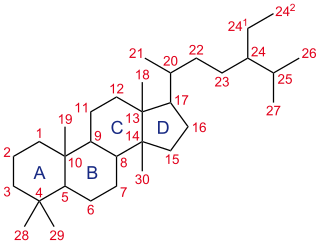Steroid hormone receptors are found in the nucleus, cytosol, and also on the plasma membrane of target cells. They are generally intracellular receptors and initiate signal transduction for steroid hormones which lead to changes in gene expression over a time period of hours to days. The best studied steroid hormone receptors are members of the nuclear receptor subfamily 3 (NR3) that include receptors for estrogen and 3-ketosteroids. In addition to nuclear receptors, several G protein-coupled receptors and ion channels act as cell surface receptors for certain steroid hormones.

The progesterone receptor (PR), also known as NR3C3 or nuclear receptor subfamily 3, group C, member 3, is a protein found inside cells. It is activated by the steroid hormone progesterone.

Allopregnanolone, also known as brexanolone, is a medication and a naturally produced steroid that acts on the brain. As a medication it is sold under the brand name Zulresso and used to treat postpartum depression. It is used by injection into a vein over a 60-hour period under medical supervision.

Telapristone (INN), as telapristone acetate, is a synthetic, steroidal selective progesterone receptor modulator (SPRM) related to mifepristone which is under development by Repros Therapeutics for the treatment of breast cancer, endometriosis, and uterine fibroids. It was originally developed by the National Institutes of Health (NIH), and, as of 2017, is in phase II clinical trials for the aforementioned indications. In addition to its activity as an SPRM, the drug also has some antiglucocorticoid activity.

Selective androgen receptor modulators or SARMs are a novel class of androgen receptor ligands.

In pharmacology, GABAA receptor positive allosteric modulators are positive allosteric modulator (PAM) molecules that increase the activity of the GABAA receptor protein in the vertebrate central nervous system.

Isopregnanolone, also known as isoallopregnanolone and epiallopregnanolone, as well as sepranolone (INN), and as 3β-hydroxy-5α-pregnan-20-one or 3β,5α-tetrahydroprogesterone (3β,5α-THP), is an endogenous neurosteroid and a natural 3β-epimer of allopregnanolone. It has been reported to act as a subunit-selective negative allosteric modulator of the GABAA receptor, and antagonizes in animals and humans some but not all of the GABAA receptor-mediated effects of allopregnanolone, such as anesthesia, sedation, and reduced saccadic eye movements, but not learning impairment. Isopregnanolone has no hormonal effects and appears to have no effect on the GABAA receptor by itself; it selectively antagonizes allopregnanolone and does not affect the effects of other types of GABAA receptor positive allosteric modulators such as benzodiazepines or barbiturates.

5β-Dihydroprogesterone is an endogenous neurosteroid and an intermediate in the biosynthesis of pregnanolone and epipregnanolone from progesterone. It is synthesized from progesterone by the enzyme 5β-reductase.

Retroprogesterone, also known as 9β,10α-progesterone or as 9β,10α-pregn-4-ene-3,20-dione, is a progestin which was never marketed. It is a stereoisomer of the naturally occurring progestogen progesterone, in which the hydrogen atom at the 9th carbon is in the α-position instead of the β-position and the methyl group at the 10th carbon is in the β-position instead of the α-position. In other words, the atom positions at the two carbons have been reversed relative to progesterone, hence the name retroprogesterone. This reversal results in a "bent" configuration in which the plane of rings A and B is orientated at a 60° angle below the rings C and D. This configuration is ideal for interaction with the progesterone receptor, with retroprogesterone binding with high affinity to this receptor. However, the configuration is not as ideal for binding to other steroid hormone receptors, and as a result, retroprogesterone derivatives have increased selectivity for the progesterone receptor relative to progesterone.

Onapristone (INN) is a synthetic and steroidal antiprogestogen with additional antiglucocorticoid activity which was developed by Schering and described in 1984 but was never marketed. It is a silent antagonist of the progesterone receptor (PR), in contrast to the related antiprogestogen mifepristone. Moreover, compared to mifepristone, onapristone has reduced antiglucocorticoid activity, shows little antiandrogenic activity, and has 10- to 30-fold greater potency as an antiprogestogen. The medication was under development for clinical use, for instance in the treatment of breast cancer and as an endometrial contraceptive, but was discontinued during phase III clinical trials in 1995 due to findings that liver function abnormalities developed in a majority patients.

Toripristone (INN) is a synthetic, steroidal antiglucocorticoid as well as antiprogestogen which was never marketed. It is reported as a potent and highly selective antagonist of the glucocorticoid receptor (GR), though it also acts as an antagonist of the progesterone receptor (PR). The pharmacological profile of toripristone is said to be very similar to that of mifepristone, except that toripristone does not bind to orosomucoid. The drug has been used to study the hypothalamic-pituitary-adrenal axis and has been used as a radiotracer for the GR. Its INN was given in 1990.

Vilaprisan is a synthetic and steroidal selective progesterone receptor modulator (SPRM) which is under development by Bayer HealthCare Pharmaceuticals for the treatment of endometriosis and uterine fibroids. It is a potent and highly selective partial agonist of the progesterone receptor (PR). As of 2017, the drug is in phase II clinical trials for the aforementioned indications.

Lonaprisan is a synthetic, steroidal antiprogestogen which was under development by Bayer HealthCare Pharmaceuticals for the treatment of endometriosis, dysmenorrhea, and breast cancer but was discontinued. It is a potent and highly selective silent antagonist of the progesterone receptor (PR). The drug reached phase II clinical trials prior to its discontinuation.

5α-Dihydronorethisterone is a major active metabolite of norethisterone (norethindrone). Norethisterone is a progestin with additional weak androgenic and estrogenic activity. 5α-DHNET is formed from norethisterone by 5α-reductase in the liver and other tissues.

5α-Dihydrolevonorgestrel (5α-DHLNG) is an active metabolite of the progestin levonorgestrel which is formed by 5α-reductase. It has about one-third of the affinity of levonorgestrel for the progesterone receptor. In contrast to levonorgestrel, the compound has both progestogenic and antiprogestogenic activity, and hence has a selective progesterone receptor modulator-like profile of activity. This is analogous to the case of norethisterone and 5α-dihydronorethisterone. In addition to the progesterone receptor, 5α-DHLNG interacts with the androgen receptor. It has similar affinity for the androgen receptor relative to levonorgestrel, and has androgenic effects similarly to levonorgestrel and testosterone. 5α-DHLNG is further transformed into 3α,5α- and 3β,5α-THLNG, which bind weakly to the estrogen receptor and have weak estrogenic activity. These metabolites are considered to be responsible for the weak estrogenic activity of high doses of levonorgestrel.
A sex-hormonal agent, also known as a sex-hormone receptor modulator, is a type of hormonal agent which specifically modulates the effects of sex hormones and of their biological targets, the sex hormone receptors. The sex hormones include androgens such as testosterone, estrogens such as estradiol, and progestogens such as progesterone. Sex-hormonal agents may be either steroidal or nonsteroidal in chemical structure and may serve to either enhance, inhibit, or have mixed effects on the function of the sex hormone systems.

EM-5854 is a steroidal antiandrogen which is or was under development by Endoceutics, Inc. for the treatment of prostate cancer. It was first described in a patent in 2008, and was further characterized in 2012. The drug acts as a potent and selective competitive antagonist of the androgen receptor (AR). Unlike other steroidal antiandrogens like cyproterone acetate, but similarly to nonsteroidal antiandrogens like bicalutamide and enzalutamide, EM-5854 is a pure or silent antagonist of the AR and shows no intrinsic partial androgenic activity. EM-5854 and its metabolite EM-5855 show 3.7-fold and 94-fold higher affinity for the human AR than bicalutamide. They also show dramatically increased antiandrogenic potency relative to bicalutamide in in vivo assays. On the basis of the available research, it has been said that EM-5854 may possibly have 70- to 140-fold the antiandrogenic potency of bicalutamide in humans. EM-5854 and EM-5855 show little to no affinity for other steroid hormone receptors including the estrogen, progesterone, and glucocorticoid receptors. As of January 2016, EM-5854 is in phase I/II clinical trials for the treatment of prostate cancer.




















